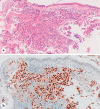Androgen Deprivation Therapy for Intracranial Metastasis of a Salivary Duct Carcinoma: Case Report
- PMID: 36844935
- PMCID: PMC9950966
- DOI: 10.1159/000529470
Androgen Deprivation Therapy for Intracranial Metastasis of a Salivary Duct Carcinoma: Case Report
Abstract
Salivary duct carcinoma (SDC) is a rare subtype of salivary cancers associated with androgen receptor and human epidermal growth factor receptor 2 (HER2/neu) overexpression. It shows a high propensity to give rise to distant metastases mainly to the lung, the bone, and the liver. Intracranial metastases are rare. We report the case of a 61-year-old male patient with SDC developing intracranial metastases. Unresponsive to radiotherapy and anti-HER/neu targeted therapy the intracranial metastases showed a very good partial remission to androgen deprivation therapy with goserelin acetate. This case demonstrates the potential of a highly targeted therapy with a relatively cheap and well-known drug in a patient with a rare disease without other good therapeutic options, which is a good example of modern, personalized medicine.
Keywords: Androgen deprivation; Case report; Intracranial metastasis; Salivary duct carcinoma.
© 2023 The Author(s). Published by S. Karger AG, Basel.
Conflict of interest statement
The authors declare to have no conflict of interest related to this work.
Figures




Similar articles
-
Metastatic Salivary Duct Carcinoma with ERBB2 Amplification and Sequential Response to Ado-Trastuzumab Emtansine and Neratinib: A Case Report.Case Rep Oncol. 2023 Nov 29;16(1):1500-1507. doi: 10.1159/000535097. eCollection 2023 Jan-Dec. Case Rep Oncol. 2023. PMID: 38033416 Free PMC article.
-
Metastatic salivary duct carcinoma in cardiac and pleural effusions: A case report with immunocytochemical analysis for androgen receptor and HER2.Mol Clin Oncol. 2019 Jan;10(1):78-82. doi: 10.3892/mco.2018.1747. Epub 2018 Oct 17. Mol Clin Oncol. 2019. PMID: 30655980 Free PMC article.
-
Androgen Deprivation Therapy for Patients with Androgen-Receptor-Positive Metastatic Salivary Duct Carcinoma: A Case Report and Review of the Literature.Onco Targets Ther. 2021 May 28;14:3481-3486. doi: 10.2147/OTT.S304900. eCollection 2021. Onco Targets Ther. 2021. PMID: 34093024 Free PMC article.
-
Combined androgen deprivation therapy in recurrent androgen-receptor-positive salivary duct carcinoma - a case report and review of the literature.J Stomatol Oral Maxillofac Surg. 2020 Nov;121(5):599-603. doi: 10.1016/j.jormas.2019.12.012. Epub 2020 Jan 2. J Stomatol Oral Maxillofac Surg. 2020. PMID: 31904529 Review.
-
Systemic therapy in the management of recurrent or metastatic salivary duct carcinoma: A systematic review.Cancer Treat Rev. 2020 Sep;89:102069. doi: 10.1016/j.ctrv.2020.102069. Epub 2020 Jul 15. Cancer Treat Rev. 2020. PMID: 32717621
Cited by
-
Complete Response in Salivary Duct Carcinoma Ex Pleomorphic Adenoma With Upfront Combination of Trastuzumab and Chemo-Hormonal Therapy.Cureus. 2025 Apr 21;17(4):e82742. doi: 10.7759/cureus.82742. eCollection 2025 Apr. Cureus. 2025. PMID: 40406786 Free PMC article.
References
-
- Kleinsasser O, Klein HJ, Hübner G. [Salivary duct carcinoma. A group of salivary gland tumors analogous to mammary duct carcinoma]. Arch Klin Exp Ohren Nasen Kehlkopfheilkd. 1968;192(1):100–5. - PubMed
Publication types
LinkOut - more resources
Full Text Sources
Research Materials
Miscellaneous

